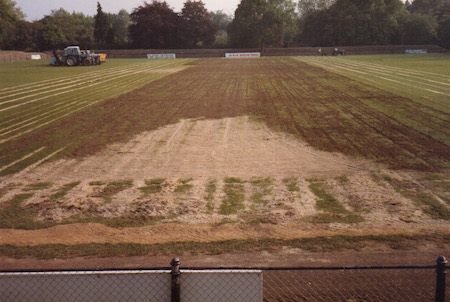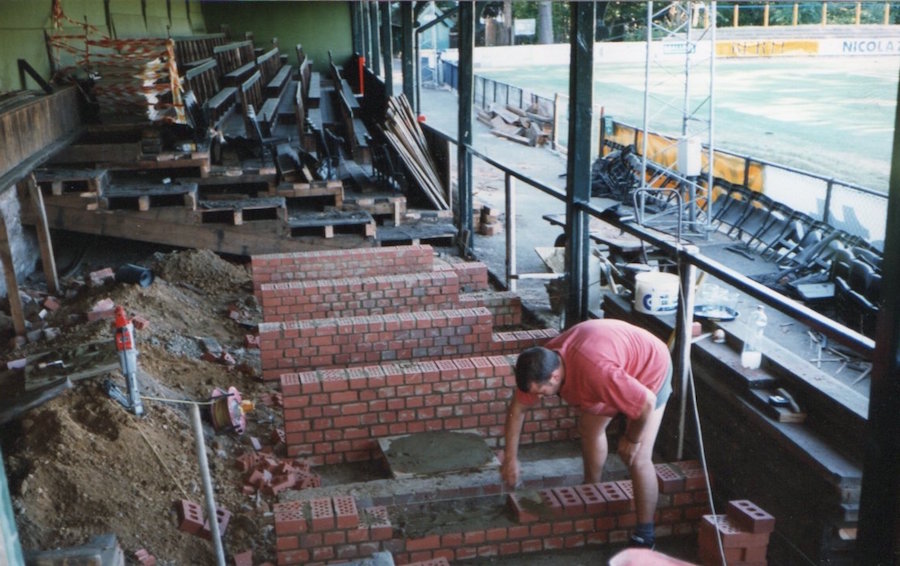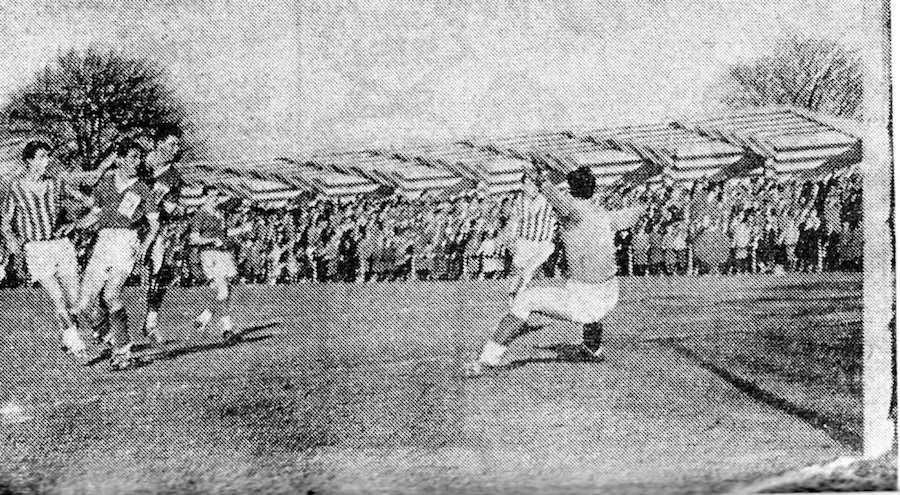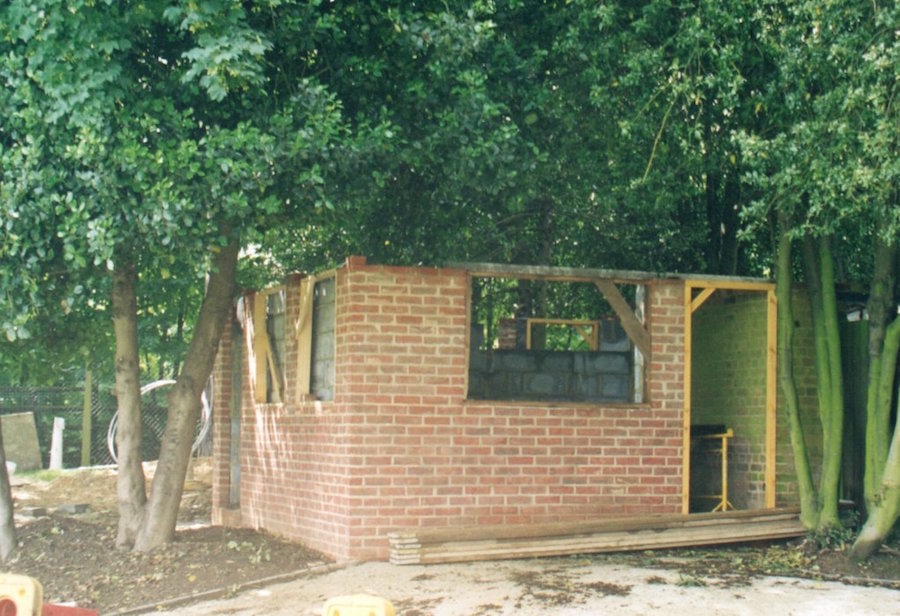Clarence Park came into existence in the summer of 1894 when Sir John Blundell Maple, MP, generously donated the twenty-four-and-a-half-acre site to the citizens of St. Albans. Until then it had been private land with its most recent owners including the Earl Spencer, Mr Jacob Reynolds and the noted German-born horticulturalist Herr Frederick Sander.

The grand opening of the park took place on a wet 23rd July, 1894, with the opening ceremony being conducted by the Duke of Cambridge. During the ceremony, Sir John, who was the Member of Parliament for Dulwich but whose home was in the sumptuous surrounds of Childwickbury Manor, had the honour of being the first person to be granted the freedom of the city of St. Albans.
The first Saints
 Football has been played at Clarence Park since the earliest possible opportunity following Sir John's generous donation. But the first club to play on the hallowed turf was not the present-day St. Albans City but the original St. Albans Football Club. Since its formation in September 1881 the original club had previously played home games at Hatfield Road, Gombards, Bernard's Heath and the old Grammar School ground off Holywell Hill.
Football has been played at Clarence Park since the earliest possible opportunity following Sir John's generous donation. But the first club to play on the hallowed turf was not the present-day St. Albans City but the original St. Albans Football Club. Since its formation in September 1881 the original club had previously played home games at Hatfield Road, Gombards, Bernard's Heath and the old Grammar School ground off Holywell Hill.
With Sir John having made public in the autumn of 1892 his intention to present Clarence Park to the local citizens there was speculation that the football club could be playing in the Park within twelve months. Unfortunately, a dry summer in 1893 delayed the preparation of the playing surface and the football club, along with the other users of the Park, had to wait a further year before they could move to their new home.
The first football match played at Clarence Park took place on Saturday, 22nd September, 1894, when the Saints drew 1-1 with Clarence whose members were employed by Sir John's London based furniture store, Maples. The honour of scoring the first goal at the Park befell Frank Mardall (right) who, unfortunately, put through his own goal to give the visitors a lead which was later cancelled out by St. Albans' Mike Sharpe. Ever since that day, right up until August 1998, the football ground at Clarence Park gained a certain notoriety for an obstruction which stood behind the goal known as the Hatfield Road end of the ground. The obtrusion was an oak tree and in that very first match it made its mark for the match reports states that, 'Hargroves (Clarence) put into the centre of the tree...'
George Wagstaffe Simmons
 The original St Albans FC underwent a couple of names changes, to St. Albans Town and then St. Albans Amateurs, until meeting their demise in 1904, more of which can be found here. The present-day St. Albans City, whose formation in 1908 owed much to the determination and vision of Mr George Wagstaffe Simmons, have been resident at the Park ever since. They have, however, through unusual circumstances, been forced on two occasion to move out temporarily. During the First World War the club had to evacuate the ground as the military moved in and it was not until during the 1919-20 season that the Football Club was allowed to return to the ground. The next time the football club vacated its home was not until the mid 1980s when much needed improvements to the drainage system (below) forced the club to play its first two home matches of the 1984-85 season on opposition soil.
The original St Albans FC underwent a couple of names changes, to St. Albans Town and then St. Albans Amateurs, until meeting their demise in 1904, more of which can be found here. The present-day St. Albans City, whose formation in 1908 owed much to the determination and vision of Mr George Wagstaffe Simmons, have been resident at the Park ever since. They have, however, through unusual circumstances, been forced on two occasion to move out temporarily. During the First World War the club had to evacuate the ground as the military moved in and it was not until during the 1919-20 season that the Football Club was allowed to return to the ground. The next time the football club vacated its home was not until the mid 1980s when much needed improvements to the drainage system (below) forced the club to play its first two home matches of the 1984-85 season on opposition soil.
Despite the occupancy of the variously named St. Albans Football Clubs at Clarence Park , that particular corner of the Park has not been used solely for the purpose of what used to be frequently referred to as the 'winter pastime.' The original plans for Clarence Park made allowances for a corner of the Park to be used for the playing of tennis and during the early days the end of the football season would see the goalposts come down and tennis played on the football pitch. This practice is known to have continued until sometime in the 1920's. During the 1930's the football ground was also the venue for a rugby match (left) with the aim of raising funds for the Durham miners who were on strike at the time, and in 1941 a boxing match took place to boost donations for the wartime Spitfire fund.


Improving the facilities
Since an area of the Park was made available for the use of football a great number of changes have taken place to bring about the appearance of the stadium as it is today. Barely a month after the first match had been played in 1894 comments were aired concerning the lack of shelter 'for the ladies.' Aware of the detrimental effect the weather could have on attendance's for football matches during the forthcoming winter Sir John sought to eradicate the problem and with a piece of exceptionally good timing one of his horses, Childwick, won the Cesarewitch at Newmarket on 10th October and from his winnings of £1,035 he donated £100 for the construction of a small pavilion. The erection was described as an 'enclosure filled with garden seats and chairs.' Another improvement made to the football ground at this time was the laying of lattice boards around the outside of the pitch for spectators to stand on.
However, it was only following the formation of St. Albans City that major alterations to the ground were made. The small stand built during 1894 was greatly extended in 1922. Plans were outlined late in the 1921-22 season to extend the existing stand from 104 feet long to 290 feet. The extension would stretch another 106 feet towards the Hatfield Road end of the ground and 80 feet towards the York Road entrance.
The existing stand had five tiers, the club planned to remove these and insert six tiers, each about one foot higher than the other. At the front of the stand would be another row of seating running the entire length of the structure, this would increase the seating by a further 200 to 1,700 seats. The club was keen to stress that it would bear the brunt of the cost, estimated at £1,000, not a penny would be contributed by the taxpayer, yet ownership of it would remain with the local Corporation. The stand may have provided seating for 1,700 when the extension was completed but various changes to sections of it and alterations in health and safety laws saw is capacity reduced to just over 500 by 2010.
 Urgent repairs were carried out to the stand in July 1996.
Urgent repairs were carried out to the stand in July 1996.
The stand may be in keeping with the appearance and character of the rest of Clarence Park but the view it offers spectators is poor with a large number of supporting struts obscuring much of the playing area. Down the years various parts of the stand have been modified for use as changing rooms, offices, the board room, sponsors lounge, a physio's room, a tea bar and, during the Covid-19 pandemic of 2020, the section nearest to the York Road entrance was altered to allow for the sale of alcohol with a patio area alongside it.
Dressing Rooms
Despite the main stand having been enlarged in 1921, the players continued to utilise the dressing room facilities within the cricket pavilion, outside the football ground, until 1929. Plans for the construction of dressing rooms were passed by the council in May 1929. The opening of the dressing tooms had been scheduled for September 30th but the grand opening did not take place until late in October with the visit of Kingstonian. Mayor W.S. Green had the privilege of conducting the opening and received from Arthur Marshall a silver ink stand bearing the inscription, ‘St Albans City Football Club. Presented to Alderman W.S. Green J.P. on the occasion of the opening of the new dressing rooms, Clarence Park , 26th October 1929’.
The new building was eighty feet in length and approximately twenty feet deep. The dressing rooms consisted of deep baths and shower facilities whilst on the entrance to the pitch the tunnel had two further rooms that housed the boiler in one and provided an office for the secretary in the other, there was also a telephone box. The boiler not only provided hot water for the baths and showers, but also for the central heating. All of which combined to give City some of the most modern and impressive facilities in the amateur game. The facilities would have been even grander had the original plans been followed through, as the intention had been to build a clubhouse on top of the main stand.
Access to the dressing rooms was made through the rear of the main stand but there was now also an entrance leading straight onto the pitch. No longer did the players have to walk through the crowd to get to and from the changing rooms inside the cricket pavilion.
The dressing rooms, though, came close to catastrophe just weeks after the opening ceremony. On 16th November, W.Collins, superintendent of Clarence Park , spotted smoke coming from the roof at 7pm. Single-handedly he climbed on to the roof and extinguished the small flames with buckets of water. When the fire brigade reached the ground they opened up the roof to discover a beam smouldering away and distinguished that before the whole place went up in flames. But for Mr Collins intervention there is no doubt that the new building and main stand would have caught alight. For training that week the players had to once again get changed in the cricket pavilion but due to discovering the fire at an early stage the damage was limited and the players were back in the football ground dressing rooms come the next match.
The dressing rooms suffered more mishap later in the season when, on 28th April, an intruder broke into the building. The would-be thief scaled the lattice metal gate at the entrance to the tunnel and is believed to have searched both dressing rooms and a cupboard before leaving empty-handed through the referee’s dressing room window. The same individual then smashed his way into the tea chalet in the main park, whose owner, Alan Manners of Upper Culver Road, said that the till had been broken into and stock disturbed but he was not certain whether anything had been stolen.
 After getting changed in the dressing rooms in the cricket pavilion, Harold Figg leads City onto the pitch in front the record Clarence Park attendance of 9,757.
After getting changed in the dressing rooms in the cricket pavilion, Harold Figg leads City onto the pitch in front the record Clarence Park attendance of 9,757.
Terracing
During the latter part of 1921 terracing was installed within the football ground. This took the form of railway sleepers, again purchased by the football club. With the enlarged main stand and installation of terracing, Club officials now estimated the ground as being capable of holding crowds of in excess of 10,000. The actual club record attendance of 9,757 saw City defeat Ferryhill Athletic 4-1 in the quarter final of the Amateur Cup on 27th February 1926. The previous Saturday another 9,745 saw City beat Southall in a 3rd Round replay. The railway sleepers were replaced by concrete terracing in 1960.
 The final touches are put to the concrete terrace in preparation for the start of the 1960-61 season.
The final touches are put to the concrete terrace in preparation for the start of the 1960-61 season.
Clubhouse
After the extension of the main stand, the most striking alteration to be seen by the naked eye occurred in 1949 when club members built the clubhouse above the dressing rooms to the back of the stand.
 1949 - Building the Clubhouse
1949 - Building the Clubhouse
The clubhouse was finished before the end of 1949 but the club was still appealing for donations of cutlery, furniture and other fittings at the end of that season.
To coincide with the construction of the clubhouse the Supporters Club, which donated £500 at the start of the project, also donated a flag.
 Club chairman Alf Hobbs gives a speech after accepting a flag from Supporters Club chairman G.Morrison on 1st October 1949.
Club chairman Alf Hobbs gives a speech after accepting a flag from Supporters Club chairman G.Morrison on 1st October 1949.
Saints light up
Having rejected an offer to move to the new sports development at Westminster Lodge in March 1962, St Albans City continued to improve the facilities at Clarence Park .
 Later that year the club provided covering on the cricket pitch side of the ground with the erection of an excellent cantilever roof. The following year saw the football club embrace midweek football under lights with the installation of floodlights. Charlton Athletic, then playing in Division Two of the Football League, sent their full First team for the official switching on of the lights on 19th November 1963. With the passing of the years the lights have been upgraded several times to meet the standard required for the level of football in which the club participates.
Later that year the club provided covering on the cricket pitch side of the ground with the erection of an excellent cantilever roof. The following year saw the football club embrace midweek football under lights with the installation of floodlights. Charlton Athletic, then playing in Division Two of the Football League, sent their full First team for the official switching on of the lights on 19th November 1963. With the passing of the years the lights have been upgraded several times to meet the standard required for the level of football in which the club participates.
(Left) Brightly shone the lights that night as Charlton’s Mike Bailey drives the ball past City ‘keeper Dave Westcott and into the Hatfield Road net to claim the first goal scored under the new lights at Clarence Park .
Many of the alterations made to the football ground have been to meet the ever-changing needs of the club to keep up with higher standards required to play at a level the club wishes.
Most of the 'improvements' have been to ensure that the club can continue to play in the Isthmian League, which it joined in 1923, but in 1998 changes were made with a view of preparing the club for a move into the Football Conference.
 The cantilever stand can be seen to be under construction as Danny Desmond scores City’s winning goal against Leytonstone on 24th March 1962
The cantilever stand can be seen to be under construction as Danny Desmond scores City’s winning goal against Leytonstone on 24th March 1962
To this end the club completely enclosed the ground during the early part of 1999 with eight-foot high metal cladding that obscures the rest of the park to those inside the ground. Whether this move has enhanced the appearance and ambience of the ground is open to conjecture but the discussions caused by the quick erection of this fence was nothing compared to the furore created by the felling of an oak tree in August 1998.
Some five years earlier the tree, which had a preservation order on it, had been cited as the reason why the club had been refused promotion to the Conference as that the league deemed it dangerous to spectators as it sat in the middle of a popular terrace. A survey of the tree in 1998 established that it was blighted with ‘brown rot,’ and Andrew Branch, the council’s Trees and Woodlands Officer, gave authority for it to be removed, which it duly was on 25th August 1998.


Also, on the theme of health and safety, crush barriers were obtained from Wimbledon’s Plough Lane ground and installed at the Park, while the segregation barriers came from Reading’s Elm Park. Turnstile units were obtained from both Manchester United’s Old Trafford home and Bolton Wanderers Burnden Park home. Tip-up seats, to replace outdated wooden benches in the main stand, were collected from Rochdale’s Spotland ground and as well as, again, from Reading.

As club merchandise became more popular throughout the game, St Albans introduced a kiosk and then a brick building for the sale of club items and run by the Supporters Club.
 No roof but the Club shop, next to the York Road entrance, nears completion.
No roof but the Club shop, next to the York Road entrance, nears completion.
International guests
Clarence Park has long enjoyed a reputation for having one of the finest playing surfaces in non-league football. The early match reports praise the high quality of St. Albans home pitch to the detriment of other grounds and down the years a large number of clubs heading for Wembley to play in the FA Cup final have stopped off at Clarence Park the day before the final for a spot of training. In 1996 the Euro 96 European Championships were held in England and Clarence Park was used for training by two of the competing nations. Up until 1998 the pitch had always been maintained by the local corporation but a disagreement over rising costs led to the club deciding to carry out their own maintenance, this situation still exists today.
On the playing side
As mentioned earlier, the first lodgers of the football ground at Clarence Park were the original St Albans Football Club (more details can be found here.). Following their demise at the end of the 1903-04 season it did look for a while that the Park would not host any more football matches for the foreseeable future. Fortunately, a replacement was found in the form of a highly successful local club, St Albans Abbey. For their first two seasons at the Park the Abbey team continued their run of success but, during 1906-07, they began to struggle to fulfil fixtures and were not in existence come the start of the 1907-08 campaign.
St Albans Abbey made encouraging noises about continuing but these failed to come to fruition and their place at Clarence Park was taken by the Old Albanians who played to the A.F.A. (Amateur Football Alliance) code. Playing Old Boys football held little interest for the locals and when St Albans City was formed on 13thApril 1908 permission was given for that club to have Clarence Park as its base.
